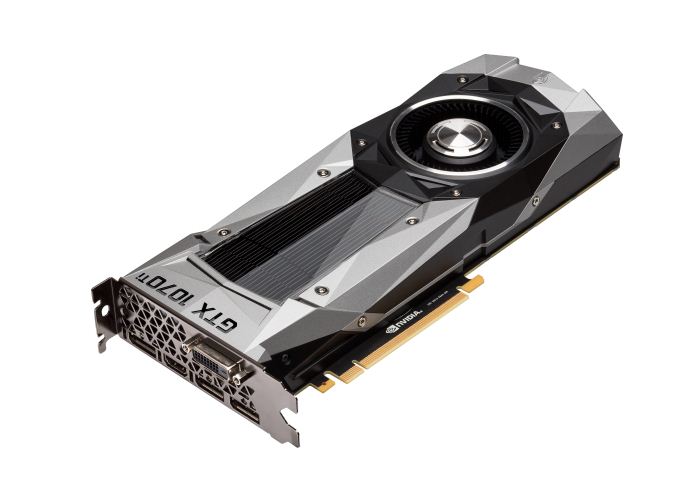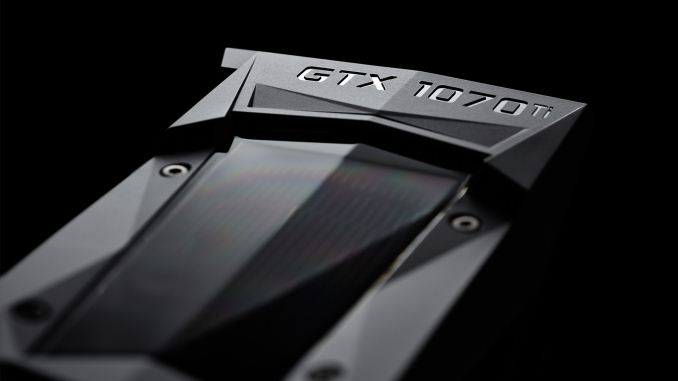The NVIDIA GeForce GTX 1070 Ti Founders Edition Review: GP104 Comes in Threes
by Nate Oh on November 2, 2017 9:00 AM EST- Posted in
- GPUs
- GeForce
- NVIDIA
- Pascal
- GTX 1070 Ti
Final Words
Bringing this review to a close, for better or worse, I think this is a launch that pulls no punches and offers no surprises. While AMD's Radeon RX Vega launch was not as impactful as many of us were hoping, it nonetheless had an impact. And that impact was against the GeForce GTX 1070, where the RX Vega 56 was fast enough to give AMD an edge on price/performance; at least when the card could be found in stock for near-MSRP prices.
Given that the RX Vega 56 placed between the GeForce GTX 1080 and GTX 1070, it was really up to NVIDIA as to if they wanted to respond, and to how. A third card in the enthusiast product stack is the straightforward solution to that problem, as it allows NVIDIA to reinforce their video card lineup against whatever foothold AMD can take. NVIDIA is playing a numbers game here – one that puts their new card just $50 below the GTX 1080 – but it's a careful calculus all the same. This is what a competitive market looks like: a little messier for sure, but also one where there are actions and reactions that give consumers more and better options.
Looking back at NVIDIA’s numbers, they seem more-or-less accurate. Based on the testing done for this review, our numbers have the GTX 1070 Ti around 13% faster than the GTX 1070, and about 8% slower than the GTX 1080. But this doesn’t support or reject the idea that the GTX 1080-1070 performance gap is capable of sustaining a new model there.
Comparing the GTX 1070 Ti head-to-head with AMD's Radeon RX Vega 56 is a little trickier, depending on the games. Generally speaking, the GTX 1070 Ti Founders Edition looks to be on the order of 5% faster than the reference RX Vega 56. The main question then returns to a matter of pricing. Just last week ahead of the GTX 1070 Ti announcement, the RX Vega 64 and RX Vega 56 were selling for $569 and $469 respectively. Since then, they've dropped by $50-$70, with retail prices running around $509 and $399 respectively, almost spot-on MSRP (if at last). Meanwhile as AMD's card prices continue to fluctuate, the new GTX 1070 Ti cards will have to remain within their $449 to $500 range, bounded by the $509 GTX 1080 and the $409 1070.
When graphics card prices change frequently, as they are now, numerous cards will drop in and out of the $250 - $550 area. Recommending the GTX 1070 Ti necessarily pigeonholes consumers to the $449 - $500 price bracket, which seems unwise when they still have the options of looking at cheaper GTX 1080 models, heavily overbuilt GTX 1070s, or even reference RX Vega 56s, all of which have been oscillating in price freely over the past couple of months. In real-world terms, as discussed earlier, today that might be the MSI GTX 1080 Armor 8G and EVGA GTX 1070 FTW Hybrid, both at the same price as a $499 GTX 1070 Ti. Or to put things another way, just last week the GeForce GTX 1070 Ti was poised to be RX Vega 56's direct competitor; this week its more of of a tantalizing spoiler for those who can reach a bit deeper into their wallets.
When it comes to comparing the GTX 1070 Ti to the RX Vega 56, it's ultimately a question of how competitive NVIDIA wishes to be and how quickly they want to react. If NVIDIA needs to completely cut-off the RX Vega 56, they can lower prices, otherwise if they just want to force AMD & vendors to bring their own prices back down to MSRP, then that job has just been done. Otherwise, looking briefly at the RX Vega 64 comparison, as you might expect from how it compares to the GTX 1080, the GTX 1070 Ti doesn't quite have the performance to outdo AMD's flagship air cooled card, leaving AMD in the lead by 5%. This means that the GTX 1070 Ti isn't the RX Vega 64's direct competitor either, however it's a potential spoiler by offering 90-95% of the gaming performance for 88% of the cost (not to mention the superior power efficiency).
Meanwhile, speaking very strictly here just within NVIDA's product stack, at today's $409/$449/$509 prices, the GTX 1070 Ti is, if only slightly, the best bargain of the three cards: it's 13% faster than the GTX 1070 for an 10% price increase, and similarly, the last 8% of the performance of the GTX 1080 comes with a 13% price premium. Otherwise all three cards are very similar, scaling in performance, price, and power consumption as you traverse the narrow $100 range. NVIDIA is pitching the GeForce GTX 1070 Ti as an upgrade for the practically legendary GTX 970, however since it launched at only $329, the GTX 970 was never this expensive. Arguably this is more of a late upgrade option for the GTX 980, but at this point I'm splitting hairs. If you are upgrading from an older NVIDIA card, you have a clear price/performance spectrum to pick from.
Otherwise, as custom GTX 1070 Ti cards hit the market over the next few weeks and settle down, it will become clearer what options they bring and how they fit into the market. Looking at our results, a factory-overclocked custom GTX 1070 Ti could easily hit GTX 1080 levels, but is not likely to be an option for precisely that reason.
Returning to the GTX 1070 Ti Founders Edition, it is a solid card with the GTX 1080 Founders Edition's vapor chamber cooler and reference 5+1 power phase PCB, all at a static $449 and reasonable power consumption. But ultimately it is a reference card with performance in between the GTX 1070 and GTX 1080, with a price to match. Given that GTX 1080 and 1070 models have been in that space for some time, that price point may be better some days and not on others for what you need. This isn't a card that is meant to drastically alter the enthusiast video card market in the last months of the year – which is to say that it doesn't do much to alter the balance between NVIDIA and AMD – but rather it's a card that is designed to offer a proportional option between the GTX 1080 and GTX 1070.












78 Comments
View All Comments
jrs77 - Friday, November 3, 2017 - link
God those GPU-prices are extreme. All across the board they're some 30% too high imho.The last GPU I bought was a GTX660, which cost just a tad under $200. Now the 1060 costs $100 more than that.
The GTX1070 should cost $350 and the GTX1080 $500. These are the price-brackets that existet just a couple years ago.
Yojimbo - Friday, November 3, 2017 - link
You're exaggerating the price differences a little. You can get a 1060 6 GB for $260, and the 1080 does start at $500. And if you had a 2 GB 660 that's a bit like the 3 GB 1060, which can be had for $205.DDR3 prices per bit are close to where they were 3 years ago, and significantly higher than 5 years ago. I'm not sure how GDDR5 prices compare for then and now, but it's a safe bet that demand outstripping supply in the memory market has affected GDDR5 as well. Then consider that the GTX 1070 has twice the VRAM as the GTX 970.
I think cryptocurrency was responsible for the high prices of graphics cards earlier this year, but as of now perhaps it's memory prices that are keeping them high. The closeness in price of the 1080 and 1070 and the big difference in price of the 1060 3 GB and 1060 6 GB probably still have to do with cryptocurrency. The 1080 and 1070 are based on the same GPU, and the pricing is affected by the yield and the demand for each card.Cryptominers demand the 1070,but not the 1080. If the 1070 is in demand relative to the the 1080 at a high ratio than the yield ratio of the GPU, it makes economic sense for the price of the 1070 to move upwards. Perhaps this situation is one reason the 1070 Ti only has one SM disabled. A similar situation exists for the 1060 3 GB/6 GB pair, pushing the 6 GB version up in relation to the 3 GB (cryptominers demand the 6 GB, I believe)
damianrobertjones - Friday, November 3, 2017 - link
I NEED to see the minimum frame rate on each of the games. It's pretty much silly to show me 565+ fps when it dips to 42fps.CiccioB - Friday, November 3, 2017 - link
Tons of graphs are presented for each game and they all measure the timings on average and minimum. Have a look at the small pics below the big graphs.letmepicyou - Friday, November 3, 2017 - link
Not a big fan of how nVidia is creating facial recognition technology to help usher in the police state...Yojimbo - Saturday, November 4, 2017 - link
Which world is freer, one where we spend our time thinking of which technologies to ban and how to ban them, then implementing bans and spending our efforts enforcing the ban? Or one where we let technology progress and then work to integrate the technology in a beneficial way (which may require changes in laws after a period of disruption)? I'd argue that the second way is freer. How we use the technology is up to us. One could argue, I guess, that the Amish face no dangers regarding facial recognition policing (although maybe that's one technology they would like, because I think the reason they reject technologies is because they don't want individuals to have the power to be free from the Amish group structure).r13j13r13 - Tuesday, November 7, 2017 - link
5 fpsGastec - Tuesday, February 20, 2018 - link
The link for EVGA GTX 1070 Ti FTW2 opens up an Amazon page that in turn leads to the Buying Option FULLFILLED BY AMAZON of only $1,099.99. That way we get to save 0.01 cents. Isn't it Amaz ing?